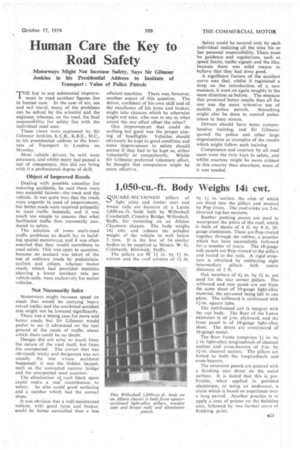Human Care the Key to Road Safety
Page 57

If you've noticed an error in this article please click here to report it so we can fix it.
Motorways Might Not Increase Safety, Says Sir Gilmour Jenkins in his Presidential Address to Institute of Transport : Value of Police Patrols THE key to any substantial improvement in road accident figures lies in human care. In the case of air, sea and rail travel, many of the problems can be solved by the scientist and the engineer, whereas, on the road, the final responsibility for safety lies with the individual road user.
These views were expressed by Sir Gilmour Jenkins, K.C.B., K.B.E., M.C., in his presidential address to the Institute of Transport in London on Monday.
Most vehicle drivers, he said, were amateurs, and whilst many had passed a test of competency, this did not bring' with it a professional degree of skill.
Object of Improved Roads
Dealing with possible remedies for reducing accidents, he said there were two material factors—the track and the vehicle. It was quite true that the roads were urgently in need of improvement„ but better roads were required primarily to meet traffic demands, and it was much too simple to assume that what facilitated traffic flow necessarily con-„ duced to safety.
The solution of some main-road traffic problems no doubt lay in building special motorways, and it was often asserted that they would contribute to road safety. This was open to question, because no account was taken of the use of ordinary roads by pedestrians. cyclists and others, whereas motor roads, which had provided statistics showing a lower accident rate per vehicle-mile, were exclusively for motor vehicles.
Not Necessarily Safer
Motorways might increase speed on roads that would be carrying heavy mixed traffic, and the combined accident rate might not be lowered significantly.
There was a strong case for more and better roads, but Sir Gilmour would prefer to sec it advocated on the real ground of the needs of traffic, about which there could be no doubt.
Danger did not arise so much from the nature of the road itself, but from the unexpected. The corner that was obviously tricky and dangerous was not usually the one where accidents happened; it was the hidden hazard, such as the concealed narrow bridge and the unexpected road junction.
The elimination of, ;,tich black spots could make a real contribution to safety. . So also could good surfacing and a camber which had the correct slope.
It was obvious that a well-maintained vehicle, with good tyres and brakes, could be better controlled than a less efficient machine. There was, however, another aspect of this question. The driver, confident of his own skill and of the excellence of his tyres and brakes; might take chances which he otherwise might not take; who was to say to what extent the one effect offset the other?
One improvement that could do nothing but good was the proper aiming of headlights. Vehicles should obviously be kept in good condition and some improvement in safety should accrue if they had to be kept so, either i7oluntarily or compulsorily. Whilst Sir Gilmour preferred voluntary effort, he thought that compulsion might be more effective. Safety could be secured only by each individual realizing all the time his or her personal responsibility. There must be guidance and regulations, such as speed limits, traffic signals and the like, because there was solid reason to believe that they had done good.
A significant feature of the accident curve was that, whilst it registered a drop on the introduction of a new measure, it went on again roughly in the same direction as before. The measure that promised better results than all the rest was . the more extensive use of mobile police patrols. Something might also be done to control pedestrians in busy streets.
Drivers should have more comprehensive training, and Sir Gilmour quoted the police and other large organizations as examples oi the results which might follow such training.
Competence and courtesy by all road users were the twin keys to safety, and whilst courtesy might be more evident in this country than elsewhere, more of it was needed.




































































































